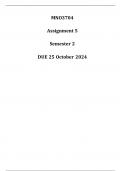MNO3704
Assignment 5
Semester 2
DUE 25 October 2024
, Question 1
How does Woolworths address energy efficiency to reduce its environmental impact and
respond to climate change?
Woolworths is committed to using energy responsibly and efficiently to reduce its
environmental footprint and contribute to climate change mitigation. Key strategies include
adopting energy-efficient technologies in stores and other facilities, such as transitioning to
energy-efficient lighting systems and automated lighting that switches off lights during non-
operational hours. Additionally, Woolworths has implemented natural lighting solutions where
possible, further reducing the energy demand. Refrigeration systems are designed to recycle
waste heat to warm stores, lowering overall energy consumption. Moreover, Woolworths has
invested in renewable energy sources, including solar power for stores, and has begun using
electric vehicles for delivery, minimizing emissions from its operations (Woolworths Holdings,
2023; Times Live, 2024).
For Woolworths, key strategies and initiatives in reducing energy consumption and carbon
emissions are part of their broader environmental and sustainability goals, known as the "Good
Business Journey." Here are some main measures and approaches they are implementing, as
highlighted in their official resources:
1. Energy Efficiency and Emissions Reductions: Woolworths aims to reduce direct emissions
by enhancing energy efficiency in operations. This includes installing smart electricity meters
across facilities and systematically tracking energy usage to identify and target high-
consumption areas. Additionally, they have incorporated energy-efficient systems and
lighting, designed to reduce overall electricity demand, particularly during peak times.
2. Renewable Energy Integration: Woolworths is progressing toward a goal of sourcing 100%
renewable energy by 2030, part of their commitment to limit the global temperature
increase to 1.5°C above pre-industrial levels. By transitioning to solar and other renewable
sources, they hope to significantly reduce reliance on carbon-intensive energy sources and
bolster resilience against fluctuating energy prices.
3. Net Zero Carbon by 2040: The company has set a science-based target to achieve net-zero
carbon emissions across its entire value chain by 2040. To realize this, Woolworths is
aligning its practices with international climate frameworks, implementing sustainable
farming initiatives, and engaging suppliers through training on reducing their environmental
footprints in areas like agriculture and manufacturing.
4. Transparency and Reporting: Woolworths places an emphasis on transparent reporting of
their carbon footprint, energy consumption, and environmental impact. They voluntarily
report to the Carbon Disclosure Project (CDP) and are working to meet the Task Force on
Climate-Related Financial Disclosures (TCFD) standards, which will guide future climate
strategy and planning.
These initiatives align with broader climate action goals such as the UN Sustainable
Development Goals (SDGs) and reflect Woolworths' commitment to fostering sustainable
practices throughout its supply chain and operational ecosystem. Through these ongoing




